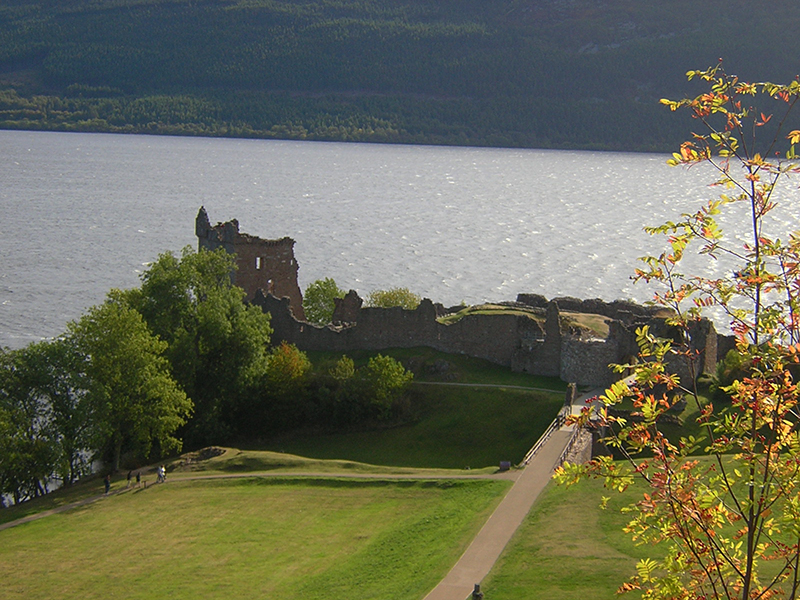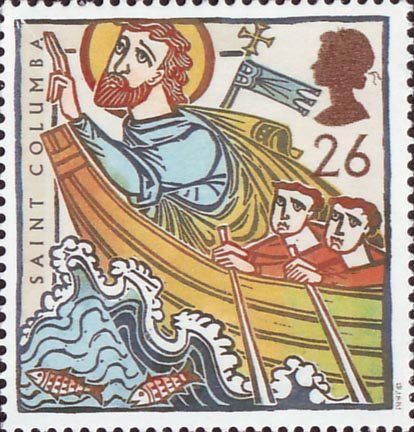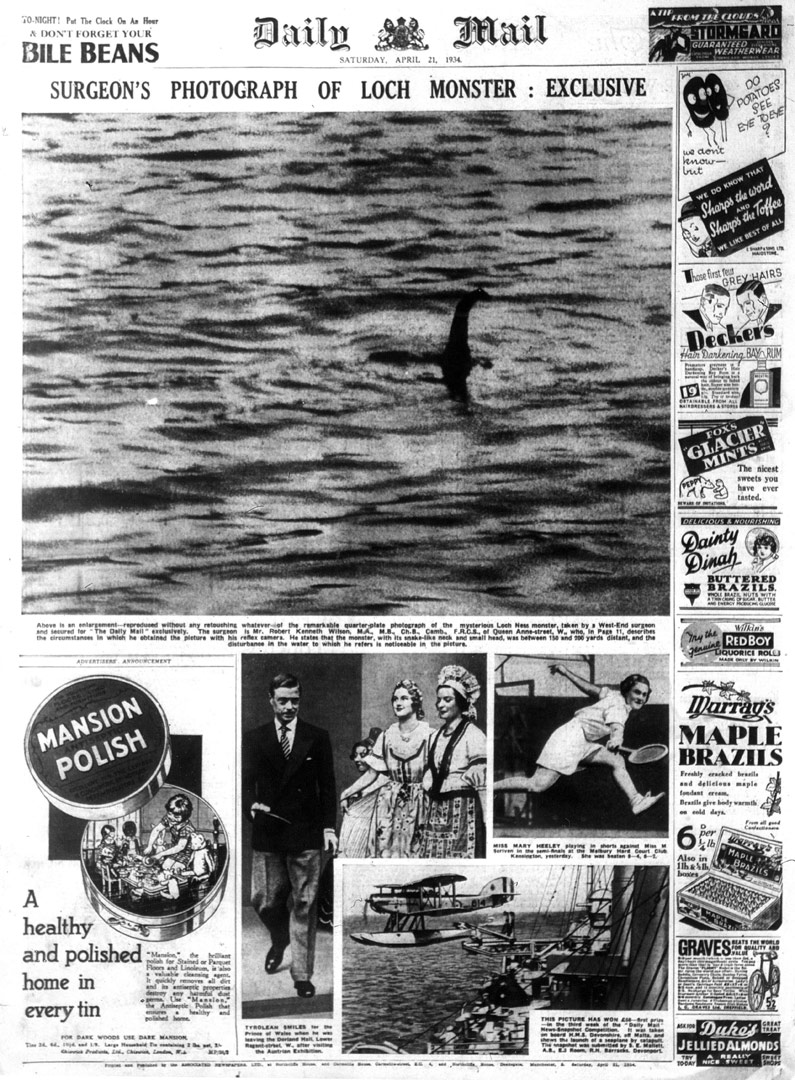Nessie in Art | The Loch Ness monster, or Nessie for short, is a cryptid (an animal such as Sasquatch that has been claimed to exist but never proven to exist) that is said to live in the murky depths of the Loch Ness Lake.
This mysterious, aquatic being has been the subject of many stories, sightings, and theories over the years. While some believe that the creature is nothing more than folklore, others fervently claim that it is real. So, what is the truth about the Loch Ness monster? Well, that depends on who you ask…

Urquhart Castle on Loch Ness © 2003 Scotiana
For some, the legend of the Loch Ness monster is just that: a legend. They believe that there is no scientific evidence to support the existence of this elusive creature. Others, however, are not so quick to dismiss the possibility.
They point to various eyewitness accounts and pieces of evidence, such as sonar readings and photographs, as proof that something strange is lurking beneath the surface of Loch Ness.
NESSIE IN ART
Nessie has been the subject of countless artistic depictions over the years. From paintings to sculptures to photographs, artists have been inspired by the mysterious creature. The first recorded sighting of the creature dates back to the 6th century, when Irish monk Saint Columba is said to have encountered a monster in the River Ness.
Futher readings: https://blogs.bl.uk/digitisedmanuscripts/2013/03/loch-ness-monster-found-at-british-library.html
Through my research I found out that one of the earliest modern artistic depictions of Nessie is a woodcut from 1933 created by Inverness Courier journalist Alex Campbell depicting a long-necked creature emerging from the water, but could not find a picture of same on the Internet.
NESSIE IN PHOTOGRAPHY ART
This photo was a sensation when published by the Daily Mail on April 21st 1934 and was immediately dubbed the ‘Surgeon’s Photo’.
The alleged photographer was London-based gynaecologist Lt. Col. Robert Kenneth Wilson MA, MB, ChB Camb, FRCS, dubbed ‘the surgeon’ in the newspapers of the 1930s. Since then, there have been hundreds of sightings. Some believe that the “monster” is a giant catfish, while others believe that it is a lost dinosaur. In recent years, DNA tests have been conducted on samples taken from the Loch, but the results have been inconclusive.
NESSIE IN LITTERATURE ART

These are just a few examples of the many books that have been written about the Loch Ness Monster or Nessie.
“The Loch Ness Monster: The Evidence” by Steuart Campbell – This book examines the evidence for the existence of Nessie, including eyewitness accounts and scientific studies.
“The Loch Ness Mystery Solved” by Ronald Binns – This book presents a skeptical view of the Nessie legend and proposes alternative explanations for the reported sightings.
“Nessie: Exploring the Supernatural Origins of the Loch Ness Monster” by Nick Redfern – This book examines the mythology and folklore surrounding Nessie, and explores the possibility of supernatural or paranormal explanations for the monster’s existence.
“The Monsters of Loch Ness” by Roy Mackal – This book provides a scientific perspective on the Nessie legend, examining the history of sightings and attempts to capture or study the monster.
“The Enigma of Loch Ness: Making Sense of a Mystery” by Henry H. Bauer – This book examines the cultural and psychological factors that contribute to the belief in Nessie, and proposes a framework for understanding the persistence of the legend.
NESSIE IN DIGITAL ART

Nessie has also been depicted in digital art and animation. For example, in 2013, Google created a Google Doodle featuring Nessie to celebrate the 81st anniversary of the Surgeon’s Photograph. The animation showed Nessie swimming through the water, looking friendly and playful.
NESSIE IN SCULPTURE ART

In 1973, a 30-foot-tall statue was erected in the village of Drumnadrochit, near Loch Ness. The statue, which was designed by artist James A. Ritchie, has become a major tourist attraction in the area. Other artists have created smaller sculptures of Nessie, such as ceramic figurines or wooden carvings.
NESSIE IN PHILATELY ART
Now, for those of you aware of my love for art in miniature such as postage stamps, rest assured, before concluding this post, I will feature at least one expression of Nessie on stamps! 
Nonetheless, one thing is for sure – the legend of the Loch Ness Monster will continue to fascinate and intrigue us for many years to come. Please share in the comments below whatever you think about it and until next, take care and all the very best!
Janice ~ Proud member of Scotiana’s team
[UPDATE – FURTHER READING]
Steve Feltham – Nessie Hunter
To say that I am a patient man would be an understatement. Having sat watching and waiting on the shores of Loch Ness full time since 1991 for one decent sighting of the monster has to be considered dedication in anybody’s eyes.
To me, however, it is more a dream come true: this subject has fascinated me since a family holiday in 1970, when I was seven.
It was then that we visited the Loch Ness Investigation Bureau, a team of volunteers who each summer set up a makeshift camp on the lochside near Urquhart Castle, from where they mounted round-the-clock surveillance in the hope of filming Nessie.
What really caught my imagination was the platform they had built, on which they had mounted a cine camera and tripod; the lens alone must have been a metre long.
Grown men looking for monsters? Fantastic.
Read more: https://www.nessiehunter.co.uk/
~~~




https://www.bbc.co.uk/news/uk-scotland-highlands-islands-65558327
Thank you for this very interesting post, Janice. Just a few days ago, the BBC published an interview with Mr Steve Feltham, an Englishman who, fascinated by all the stories about Nessie, moved from Dorset to the shores of Loch Ness in 1991 to monitor the movements of the Monster. The ‘Surgeon’s Photograph’ that you mention from 1934, Janice, must have caused quite a sensation, for the camera does not lie! Modern interest in Nessie seems to have begun the year before – in April 1933 – when a lady by the name of Aldie Mackay, a hotel manager, reported the sighting of a huge, black creature – although she had no photographic evidence.
I’m a huge fan of Wikipedia, Janice, as I’m sure you know! Loch Lomond is listed as Scotland’s longest loch (at 39km), while Loch Ness has the largest volume of water. Loch Morar, however, although only 26km in length, has the deepest water – 310 metres in places – in whose darkness lurks Morag, sometimes described as a sister of Nessie. (‘Grandmother’ or even ‘Great Grandmother’ might be more accurate, for it has been claimed that the first sighting of Morag was in 1887!)
Once again, I’m indebted to Wikipedia. “Between 1887 and 1981, 34 sightings of Morag have been recorded – of which 16 were by multiple witnesses.” So, Morag’s story is largely untold. Are you busy next week, Janice? 🙂
Iain.
Hi Iain,
Thank you so much for your comment and for sharing additional fascinating information about Loch Ness and its mysterious inhabitants. It’s always a pleasure to learn more about the legends and stories surrounding Nessie and Morag. I find it truly remarkable how people like Mr. Steve Feltham dedicate their lives to studying and monitoring the movements of the Loch Ness Monster.
I share your admiration for Wikipedia, which is a fantastic resource for expanding our knowledge on various subjects. It’s a great platform for discovering and exploring interesting facts and stories like the ones you’ve mentioned.
Thanks again for your engaging comment, Iain!
Best regards,
Janice